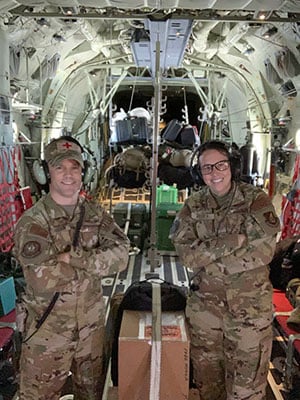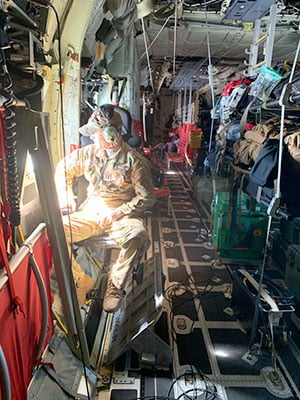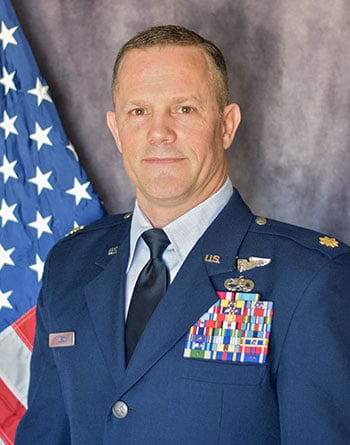“I was feeling so frustrated – I felt like I hit a ceiling in my career, it wasn’t going where I intended.”
|
Major Jake Thueson is now a CU Nursing student in the Master of Science program. |
Major Jake Thueson was frustrated with his career as a mechanic in the Air Force. He started basic training in the Air Force in 1998, earned his Bachelor of Science in Aeronautics, and worked as a mechanic for 10 years. He loves serving his country, airplanes, and flying – but he wanted more.
When his daughter fell ill and spent months receiving treatment, Thueson came face to face with the healthcare system.
“I started chatting with a male Army nurse in the middle of the night when he was doing his nurse things, and I shared with him the frustrations I was having with my degree and career, and he said ‘If you want, you could do this job (as a nurse) and it’s very fulfilling’,” Thueson says. “I fell in love with everything he was telling me, so I decided to pursue a nursing degree.”
He spent three years in the Air Force Reserves while attending a nursing program in Idaho and returned to active duty as a nurse in 2011. In July 2019, he became a flight nurse, which combined his previous experience and love of flying with his current experience and education in nursing.
Thueson was drawn to a career as a flight nurse because of his aeronautics degree. He had taken classes about open-air transportation and cargo logistics. He was familiar with airplanes – and felt comfortable around them.
He’s spent more than a decade as a nurse and is now enrolled in the Adult-Gerontology Clinical Nurse Specialist (AG-CNS) Master of Science program at the University of Colorado College of Nursing at Anschutz Medical Campus.
Thueson had nurse mentors from previous assignments who were selected for scholarships and had attended the AG-CNS program at CU Nursing. They enjoyed Colorado and had nothing but great things to say about the program and faculty here, especially their flexibility to work with military students on scholarships and some of the unorthodox requirements accompanying them.
What is a Flight Nurse? And What Do They Do?

Major Jake Thueson and crew onboard an Air Force plane. |
People might picture something where a helicopter transports people from a car crash to a hospital. Thueson says that’s more of what the Army does with its helicopters. Instead, the Air Force uses a large plane (think of a Boeing 737), but without your typical rows for passengers.
“We’ll set up a hospital room – or even a small hospital – inside the back of the airplane. That way, we can move patients and their families longer distances,” he says. “For example, when I was stationed in Okinawa, we would fly to South Korea, Guam, or small Pacific islands where maybe someone in the Navy got sick, and then we’d transport them to a larger military hospital in Hawaii or San Diego.”
Thueson has been stationed at three military bases as a nurse: an Adult Critical Care Nurse at Travis Air Force Base in California, a Pediatric Critical Care Nurse at Walter Reed National Military Medical Center in Maryland, and an Aeromedical Evacuation (Flight) Nurse at Kadena Air Base in Okinawa, Japan.
He says his favorite aspects of being a flight nurse are treating patients and their families – and flying.
“Being around the airplanes, out on the flight deck, and in the flying world in the Air Force,” he says. “Sometimes when you’re in a hospital on a base, it’s easy to forget you’re in the Air Force because you’re deep inside a hospital with no windows. So this job reminds me that I’m part of the Air Force.”
Flying in the Future

Major Jake Thueson onboard an Air Force plane. |
Right now, Thueson is still on active duty but is not required to report for daily duties at a base. Instead, he’s considered a full-time student, attending classes and clinical rotations, while maintaining his physical fitness standards, medical clearances, and other life-saving certifications.
Thueson will graduate from CU Nursing this summer. Earning a Master of Science degree specializing in AG-CNS degree will allow Thueson to work as a flight nurse for another assignment. He will likely be stationed in Illinois, one of the two stateside military bases with active flying squadrons. The other is in California.
“(In Illinois) I will be mostly educating younger nurses and medics,” he says. “I’ll be making sure evidence-based practices in nursing are used and actualized at the bedside in practice within the Air Force.”
He says his time at CU Nursing has helped prepare him to transition into an educator role in the nursing field.
“With clinical hours they have been so flexible,” he says. “They’ll ask where you want to focus your clinical hours, and I said to put me in outpatient clinics since I see a wide variety of patients as a flight nurse.”
And his advice for nursing students is simple: start at the bottom because you can only go up from there.
“Start as a medical assistant or a nurse assistant,” he says. “When I went from being a mechanic to being a nurse, I went back to the bottom of the food chain. But it didn’t take too long for me to move up – I spent a few months learning the basics and advanced quickly. So start at the bottom, get good work experience, and work your way up.”




